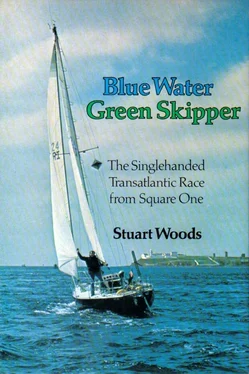On November 20, O.H. and I motored Harp up the harbor and delivered her into the hands of Southcoast Boatyard for her “immediate” repairs. On December 1 I left for my home in Georgia, to spend the Christmas holidays there. I stopped by the yard to see how work was progressing. I had a talk with them about it, and they promised to be well along with her when I returned in January.
I spent five weeks in the United States, working on the early chapters of this book, visiting friends at home in Manchester and in Atlanta, looking into the family business, a clothing business rapidly becoming a department store which needed further expanding, and just relaxing. Only one event occurred that might have had a bearing on my entry in the OSTAR.
My last week at home I did something to my back which made it very sore — a muscle strain, I figured. Then, on the day of my departure for Ireland, then London and the boat show, I was bending over the sink shaving when something down low snapped, and I was suddenly in excruciating pain. I tried to delay my departure for a day, but the only flight I could get was the one I was already booked on, so, walking in a rather peculiar way, I arrived at Atlanta Airport, struggled up to the Delta Airlines ticket counter, and said in a strangled voice, “Do you think you could get me a wheelchair, please?” The startled girl behind the counter picked up a telephone, spoke a few words, and within seconds a man with a wheelchair materialized at my elbow. My ticket was processed instantly, the gross overweight of my luggage was overlooked, and it was shipped straight through to Shannon Airport against all regulations, since I was stopping in New York.
Moments later, I was being wheeled at a rapid clip down the two and a half miles of corridor to my departure gate (it is always two and a half miles to my departure gate), sailing through the security search with hardly a pause, the wind made by our swift pace cooling our passage every step of the way. It occurred to me that I had inadvertently discovered a wonderful new way to travel in airports. I recommend it.
I was put on the plane before the other passengers, made comfortable, given a quick glass of water with which to down the large painkilling pill I was waving about, and given the first drink when the bar opened. At Kennedy Airport, New York, I was met by another wheelchair, my New York — routed luggage appeared in record time, and I was deposited in a taxi without my feet ever touching the ground. I believe I was passed from person to person so quickly because each of them was afraid I would die while in his hands.
After a two-day visit with my old friend Carol Nelson (remember our experience with the Mini and the incoming tide?), this entire performance was repeated in the Aer Lingus terminal at Kennedy, at Shannon Airport in Ireland, and, eventually, at Heathrow in London. This, I thought, is the only way to go.
I hobbled through the London Boat Show, stoned out of my mind on painkillers (all the back doctors in London had flu or were out to lunch, or something — it was a week before I could persuade one to see me), tying up loose ends as best I could. I ordered an excellent new suit of oilskins from Morgan of Cowes, the yachting tailors, and four Javlin Warm Suits, in case I decided to take the northern route in the OSTAR. I also bought an excellent signaling torch, and Camper measured the standard Golden Shamrock at the show in order to make a much-needed sprayhood for Harp. I also had a long lunch with Tim Stearn of Stearn Sailing Systems to talk over modifications to the Dynafurl, and he promised to supply me with a newly designed unit which would solve all my problems.
When I finally got to see a back specialist, he ushered me into a large gilt office; poked here and lifted there, ignoring my screams; then laid me on an altar-like slab in the middle of the room, stuck a needle into my backbone, and lubricated my spine as if it were the crankshaft of a Fiat 128. This hurt only slightly more than my original back problem. I left his office, poorer by £25, clutching an orthopedic back cushion and a prescription for more painkillers.
Fortunately, my back did not hurt when I lay down, which meant I could sleep well, or when I was sitting, which meant I could eat well.
Ann and I toured our favorite restaurants, and I enjoyed the occasional dinner with other old friends. Angela Green of The Observer, whom I had met at the start of the Azores and Back Race in Falmouth the summer before, joined me for lunch one day and brought me up to date on the Race. At the close of entries on December 31, 1975, there had been 197 entries received, and all hell was breaking loose in the yachting press. Disaster at the start was being predicted from all sides, and there was a lot of bitching about the acceptance of Alain Colas’s huge 236-foot yacht, Club Méditerranée .
I, for one, was delighted to have the big boat in the race, since it stimulated so much discussion, although I was not going to be sailing across her bows at the start, screaming, “Starboard.”
In early March I made a reconnaissance trip to Plymouth and managed to combine business with pleasure. I had never been to Plymouth and I was anxious to have an advance look at the facilities well ahead of the race. Ann joined me for the trip. First, we visited the Royal Western Yacht Club of England, which would be organizing and running the race, and as we walked down the steps to the waterside setting of this famous club, we were greeted with a bit of drama.
A bright red trimaran was in a lot of trouble. He had apparently tried to sail away from a club mooring, had got into irons and drifted dangerously close to the rocky shoreline and to the sea wall in front of the club. He had flung out an anchor, which was holding his bows off, then somebody from the club had thrown him a stern line. That somebody turned out to be Lloyd Foster, secretary of the Royal Western and every OSTAR aspirant’s main contact with the race committee. Lloyd turned out to be a calm, boyish-looking fellow, in spite of long naval service going back to navigator’s duties on a World War II destroyer. He settled Ann in the drawing room with a magazine and sat me down in his office. I had a dozen questions and he had all the answers: yes, there was a good yard where I could make advance arrangements for any last-minute repairs to Harp ; yes, there would be a shipping company at Millbay Docks to collect any extra gear from competitors and send it ahead to Newport; no, we could not use our engines at the start, no matter how many boats entered; yes, there would be plenty of space for 197 boats in Millbay Docks, etc., etc., etc.
We chatted for an hour or so, and I was relieved to discover that the committee was unperturbed by all the criticism being leveled at the race. The controversy centered on the number of boats and the fact that a single-hander cannot keep a lookout at all times, which, according to the Race’s detractors, made single-handing unseamanlike. What the detractors preferred to overlook was the fact that the start would be postponed if there were fog or extreme weather, and that every entrant knew that he would have to stay awake for the first two days of the race until he was across the continental shelf and out of the fishing fleets.
The editorials and letters to the editors seemed to imply that the full burden of avoiding collisions rested on the single-hander, and that merchant ships and fishermen were never at fault in these circumstances. On the passage from Horta to Crosshaven I had once, on a bright sunny day, come on deck to find a large merchant vessel dead ahead of me on a reciprocal course. I had borne away to avoid a collision, and as the big ship sailed past me I never saw a soul on her decks or bridge. This is not an unusual situation at sea, and I believe that if the standard of watch maintained on most yachts, even single-handers, were maintained by merchant seamen and fishermen, there would be few, if any, collisions at sea.
Читать дальше












